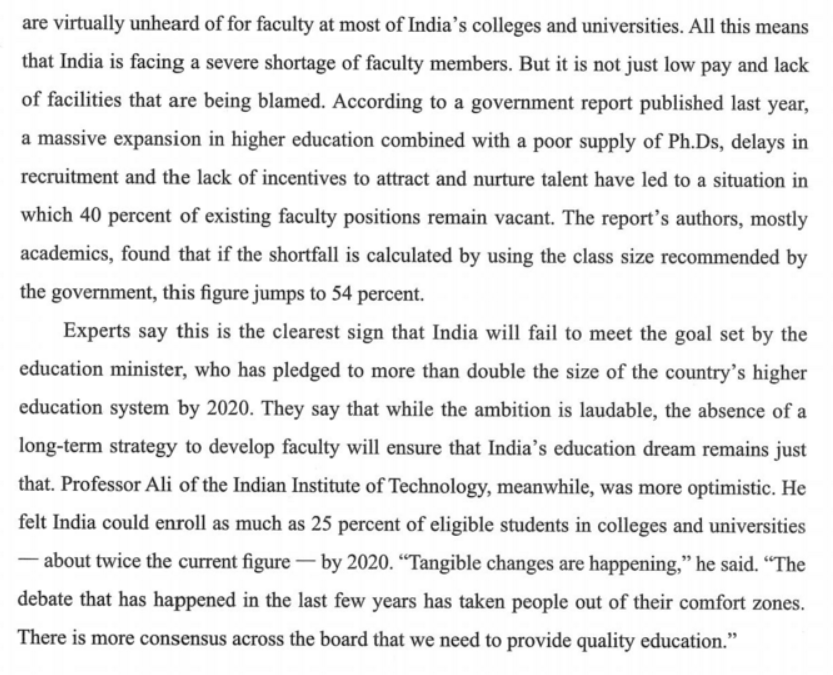- As one of the the better colleges and Indian’s capital, there is just one large room for 140 faculty members to sit and have a cup of tea or grade papers.
- “ Even if half show up there aren’t enough chairs,” said Amy, a history professor there.
- After 30 years at the Mary College, which is one of dozens administered by the University of Delhi, Ms. Amin makes the equivalent of US$22000 a year—less than half of what some of her better students will make in their first jobs.。
- According to a government report published last year, a massive expansion in higher education combined with a poor supply of Ph. Ds, delays in recruitment and the lack of incentives to attract and nurture talent have led to a situation in which 40 percent of existing faculty positions remain vacant.
- He felt India could enroll as much as 25 percent of eligible students in colleges and universities— about twice the current figure— by 2020.
- “Tangible changes are happening.” he said. “The debate that has happened in the last few years has taken people out of their comfort zones. There is more consensus across the board that we need to provide quality education.”


As one of the the better colleges and Indian’s capital, there is just one large room for 140 faculty members to sit and have a cup of tea or grade papers. “ Even if half show up there aren’t enough chairs,” said Amy, a history professor there. “There is no other place to work. In this situation, how do you expect teachers to work?” The lack of amenities for faculty members is not the only issue .After 30 years at the Mary College, which is one of dozens administered by the University of Delhi, Ms. Amin makes the equivalent of US$22000 a year—less than half of what some of her better students will make in their first jobs. New opportunities offer not just more money for graduates but also mobility and flexibility, which are virtually unheard of for faculty at most of the Indians colleges and universities. All this means that India is facing a severe shortage of the faculty members. But it is not just low pay and the lack of facilities that are being blamed. According to a government report published last year, a massive expansion in higher education combined with a poor supply of Ph. Ds, delays in recruitment and the lack of incentives to attract and nurture talent have led to a situation in which 40 percent of existing faculty positions remain vacant. The report’s authors, mostly academics, found that if the shortfall is calculated by using the class size recommended by the government, this figure jumps to 54 percent.
Experts say this is the cleareat sign that India will fail to meet the goal set by the education minister, who has pledged to more than double the size of the country’s higher education system by 2020. They say that while ambition is laudable, the absence of a long-term strategy to develop faculty will ensure that Indian’s education dream remains just that. Professor Ali of the Indian Institute of Technology, meanwhile, was more optimistic. He felt India could enroll as much as 25 percent of eligible students in colleges and universities— about twice the current figure— by 2020. “Tangible changes are happening.” he said. “The debate that has happened in the last few years has taken people out of their comfort zones. There is more consensus across the board that we need to provide quality education.”
玛丽大学是印度首都排名前几所的大学,全校却只有一间大一点的屋子,能容纳140名教职工坐下来喝杯茶、改改卷子。艾明(Amin)是那所学校的历史教授。他说:“全体教职工就算只来一半,这房间也不够坐的。学校也没别的地方办公。就现在这情形,老师还怎么干下去?”事情远不止办公空间小这么简单。艾明受戴耳西大学(Delhi)任命,上岗30年,一年却只能拿到两万二美元。拿她教出来的学生来说,好一点的,第一份工作的薪水都比这个数的两倍还要多。印度毕业生有新的工作机遇,能拿到更多钱,工作安排灵活多变,可专科院校和大学的教职工却从没有这样的待遇。印度正面临教职工紧缺,究其原因,不仅仅是薪水低、设施不全的问题。去年政府报告显示,高等教育行大幅扩张,博士人才供给不足,招新频频延迟,难以吸引、培养高精尖人才,高等教育教职工职位空缺率为40%。报告撰写者多大是学界人士。他们表示,倘若按照政府提供的教职工规模来算,空缺率得到54%。
教育部部长许诺2020年印度高等教育规模将扩大不止一倍。专家纷纷表示,按现在的情况看,这目标定是达不到了。专家还表示,部长雄心值得一赞,可若不制定长远规划发展高等教育教职工群体,梦想永远变不成现实。印度科技部主席阿里(Ali)则更为乐观。他认为,2020年印度高等教育院校招揽的合格学生会是现在的两倍,达到25%。他说:”变化是还是能感受到的。过去几年大家就对印度高等教育发展前景争论不休,走出了自己的舒适区。越来越多的人认为,国家要提供素质教育。
As one of the the better colleges and Indian’s capital, there is just one large room for 140 faculty members to sit and have a cup of tea or grade papers.
玛丽大学是印度首都排名前几所的大学,全校却只有一间大一点的屋子,能容纳140名教职工坐下来喝杯茶、改改卷子。
- the better理解:条件较好
“ Even if half show up there aren’t enough chairs,” said Amy, a history professor there.
艾明(Amin)是那所学校的历史教授。他说:“全体教职工就算只来一半,这房间也不够坐的。
- 句子衔接:该校的…
After 30 years at the Mary College, which is one of dozens administered by the University of Delhi, Ms. Amin makes the equivalent of US$22000 a year—less than half of what some of her better students will make in their first jobs.。
艾明受戴耳西大学(Delhi)任命,上岗30年,一年却只能拿到两万二美元。拿她教出来的学生来说,好一点的,第一份工作的薪水都比这个数的两倍还要多。
- which指代Mary College,不是Ms. Amin
According to a government report published last year, a massive expansion in higher education combined with a poor supply of Ph. Ds, delays in recruitment and the lack of incentives to attract and nurture talent have led to a situation in which 40 percent of existing faculty positions remain vacant.
去年政府报告显示,高等教育行大幅扩张,博士人才供给不足,招新频频延迟,难以吸引、培养高精尖人才,高等教育教职工职位空缺率为40%。
- a massive expansion in higher education 高校大规模扩招
- a poor supply of Ph. Ds 博士
- incentives 漏译
- remain vacant 有待补缺
He felt India could enroll as much as 25 percent of eligible students in colleges and universities— about twice the current figure— by 2020.
他认为,2020年印度高等教育院校招揽的合格学生会是现在的两倍,达到25%。
- 毛入学率 …percent of eligible students
“Tangible changes are happening.” he said. “The debate that has happened in the last few years has taken people out of their comfort zones. There is more consensus across the board that we need to provide quality education.”
他说:”变化是还是能感受到的。过去几年大家就对印度高等教育发展前景争论不休,走出了自己的舒适区。越来越多的人认为,国家要提供素质教育。
- be taken out of comfort zones 无法安于现状
- quality education
素质教育 liberal education

